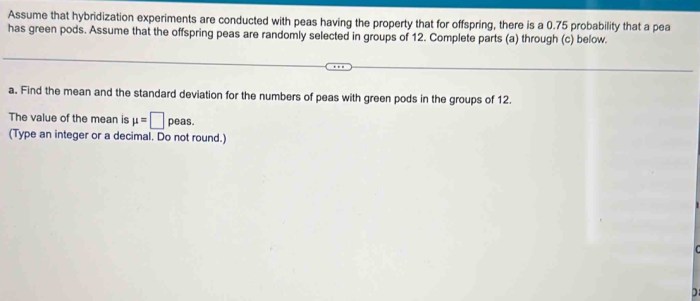Assume that hybridization experiments are conducted with peas: this premise serves as the cornerstone of our exploration into the captivating realm of genetic inheritance. Gregor Mendel’s pioneering work with pea plants laid the foundation for our understanding of the fundamental principles governing the transmission of traits across generations.
Through carefully designed experiments, Mendel elucidated the role of hybridization in unraveling the mysteries of genetic inheritance. Peas, with their distinct and easily observable traits, proved to be an ideal model organism for this groundbreaking research.
Genetic Inheritance and Hybridization

Gregor Mendel’s pioneering work on pea plants laid the foundation for our understanding of genetic inheritance. Hybridization, the process of crossbreeding individuals with different traits, played a pivotal role in Mendel’s experiments.
Hybridization allows researchers to study the transmission of traits from parents to offspring, revealing the underlying genetic principles that govern inheritance. The use of peas in Mendel’s experiments was particularly advantageous due to their distinct and easily observable traits, such as seed color, seed shape, and plant height.
Experimental Design and Procedures, Assume that hybridization experiments are conducted with peas
Mendel’s hybridization experiments involved carefully controlled cross-pollination and self-pollination techniques. Cross-pollination was achieved by transferring pollen from the anthers of one plant to the stigma of another plant, while self-pollination involved transferring pollen within the same flower.
Maintaining accurate records of the parental genotypes and phenotypes was crucial for analyzing the inheritance patterns. Mendel also controlled for environmental variables to ensure that any observed variations were due to genetic factors rather than external influences.
Phenotypic Variation and Dominant/Recessive Traits
Mendel’s experiments revealed distinct phenotypic variation among pea plants. He identified seven pairs of contrasting traits, such as yellow versus green seeds, round versus wrinkled seeds, and tall versus short plants.
Mendel proposed the concepts of dominant and recessive traits. A dominant trait masks the expression of a recessive trait when both alleles are present in an individual’s genotype. For example, in the case of seed color, the yellow allele is dominant over the green allele, resulting in yellow seeds even if the plant carries one copy of the green allele.
Segregation, the random separation of alleles during gamete formation, ensures that each gamete carries only one allele for each trait. This process contributes to the phenotypic ratios observed in offspring.
Genotype and Phenotype
The genotype of an individual refers to its genetic makeup, while the phenotype refers to its observable traits. Mendel’s experiments demonstrated that the genotype determines the phenotype, but the relationship is not always straightforward.
Genetic variation, arising from mutations and genetic recombination, contributes to phenotypic diversity. Individuals with different genotypes can exhibit similar phenotypes, a phenomenon known as incomplete dominance. Alternatively, a single genotype can produce different phenotypes under varying environmental conditions.
Punnett Squares and Probability
Punnett squares are a graphical tool used to predict the probability of inheriting specific traits. They represent the possible combinations of alleles that can be passed on from parents to offspring.
For monohybrid crosses, Punnett squares predict the genotypic and phenotypic ratios of offspring based on the genotypes of the parents. For dihybrid crosses, the squares predict the probabilities of inheriting specific combinations of alleles for two different traits.
Probability plays a crucial role in understanding genetic inheritance. By using Punnett squares and probability calculations, researchers can predict the likelihood of specific traits appearing in offspring, providing valuable insights into the transmission of genetic information.
FAQ Compilation: Assume That Hybridization Experiments Are Conducted With Peas
What is the significance of using peas in hybridization experiments?
Peas possess distinct and easily observable traits, making them an ideal model organism for studying genetic inheritance. Their short generation time and ease of cross-pollination further contribute to their suitability for experimental purposes.
How did Mendel’s hybridization experiments contribute to our understanding of genetic inheritance?
Mendel’s experiments revealed the fundamental principles of genetic inheritance, including the concepts of dominant and recessive traits, segregation, and independent assortment. These principles laid the foundation for modern genetics.
What is the role of Punnett squares in understanding genetic inheritance?
Punnett squares provide a visual representation of the possible combinations of alleles that can be inherited from parents. They are a valuable tool for predicting the probability of inheriting specific traits and understanding the patterns of inheritance.


